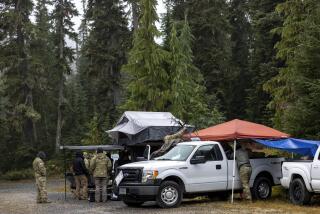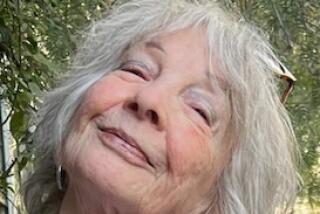Her Memory Still Soars
Written for the female pilots of World War II, the poem âCelestial Flightâ still brings chills at their funerals and warm recollections on Memorial Day.
âShe is not dead -- But only flying higher, Higher than sheâs flown before,â begins the soulful elegy read at the funerals of Americaâs last-remaining members of the Womenâs Airforce Service Pilots program, known fondly as the WASP. The poem is also recited at the funerals of many other female pilots.
This Memorial Day, the woman whose death inspired it is being honored again by her family members as they await the return of a few last personal belongings recovered in February at the Mojave Desert site where the B-25 bomber she was co-piloting crashed in 1944.
The life of Marie Michell Robinson was a tragic World War II story of love found and lost that read like a movie. Now it may have a Hollywood ending.
Robinson, who earned her wings as a WASP, died in a fiery crash just days after her secret marriage to an Army doctor from a wealthy Texas family.
Robinson, who was 20, was stationed at Victorville Army Air Field, about 70 miles northeast of Los Angeles in the High Desert. In a letter to her father written the day before she died, the flier said she was thinking of getting married âone of these days.â
About a week later, her family was surprised when Maj. Hampton C. Robinson accompanied her body to Michigan, Marieâs home state, and announced that they had been married in Reno two weeks before she died.
Marie Robinson and two other crew members perished when their twin-engine bomber plunged into the desert Oct. 2, 1944. Her story ended with the funeral and the poem, written the day of the crash by a fellow WASP. Or so the family thought.
Every Memorial Day, Marie Robinsonâs brother, Roy G. Michell, has saluted his sister and her short but patriotic life. But this year is special: A few last remnants of her life are coming home.
Earlier this month, he was rocked by a phone call from a stranger in California who said he had recovered his sisterâs bracelet, her Bulova watch, wedding band and her uniform collar insignia from the wreck site.
The brother, himself a World War II veteran, knew about the bracelet. It was a gift from his mother, who had given her son and daughter bracelets with their names engraved when they went off to war.
The stranger on the phone was David Schurhammer of Fullerton, an amateur aviation archeologist who related how he and two associates became aware of the 1944 plane crash involving a WASP and began to search for the wreckage.
He obtained a copy of the crash report from the Air Force, learned that Robinson was among the victims and began the hunt. After an Internet search, he learned of the poem written about Robinson and found several photos of her.
Still, Schurhammer, G. Pat Macha of Huntington Beach and Machaâs son, Pat, had not located the crash site. It became an obsession for the âwreck finders,â as they call themselves. Only after searching on and off for more than a year did they come upon the wreckage in February along with a few mementos of the young pilot.
âShe was so young and beautiful. The secret marriage. The tragic death. The hands on her watch stopped at 1:40 p.m., the time of the crash,â Schurhammer said. âYou couldnât make up a story like this one.â
The aircraft was piloted that day in October 1944 by Lt. George D. Rosado, whose wife lived in San Diego. The other crew member was Staff Sgt. Gordon L. Walker, from John Day, Ore. Schurhammer also has some of their possessions that he wants to return to their families.
Marie Robinsonâs brother was stunned when the phone call came to his home in Purcellville, Va., a suburb of Washington.
âAll of this seems like a movie, but the ending wasnât really the end. To know that she was wearing [the recovered items] that day. Well, I donât know what to think,â he said.
As Memorial Day approached, Michell found himself thinking more about his sister, nudged along by a melange of emotions and memories. Always proud of what she had accomplished, Robinson and 1,073 other WASPs blazed a trail for women who today routinely fly for all branches of the military, Michell said.
âMarie was the only one in the family who died while in the service. Memorial Day has a special significance this year,â he said.
Robinson was not scheduled to fly the B-25 she co-piloted on that fateful day.
âShe was in her room, writing a letter to my mother. Her roommate was supposed to fly, but she had a toothache. My sister said sheâd fly instead -- not a surprise because she loved flying. Mother received the letter after Marieâs death. It tore her apart. She grieved the rest of her life,â he said.
Although Robinson served in uniform less than seven months, her story has become part of WASP lore. âCelestial Flight,â written by her best friend and fellow WASP Elizabeth âKitâ MacKethan Magid, was meant to preserve her memory. Magid, who died last year at 86, is buried at Arlington National Cemetery.
Michell marvels at how much his sister accomplished in her brief life. As a teenager, she danced professionally at the swank Edgewater Beach Hotel in Chicago, where she lived with her mother and stepfather after her parents divorced. She graduated from preparatory school in Maryland when she was 18 and had a private pilotâs license before she joined the WASP.
He recalled his sisterâs wartime romance with Robinson, a doctor nine years her senior whom she met in Dallas. The love affair continued after she was assigned to Victorville. Her husband went on to remarry two more times and become a prominent Houston surgeon, according to the Houston Chronicle. He died in February 1988.
The WASP program was in existence for only 22 months, from 1942 to 1944, and members were civil servants, not military pilots. About 25,000 women applied for the program, but only 1,830 made the cut. Of these, 1,074 graduated from the training program. Robinson was one of 38 WASPs who died while ferrying fighter planes, bombers, cargo planes and other aircraft across the United States for the military.
For the privilege of serving their country, the women earned $250 per month and had to pay for their own uniforms, food and lodging at the military installations where they were stationed. They finally received veteran status in 1979.
In an era when World War II memories are catching public attention, the WASPs are also snagging Hollywoodâs attention. Stuart Benjamin, producer of âRay,â the Oscar-winning 2004 movie about singing legend Ray Charles, is among those interested. He said he would focus on âgetting the WASP story told.â
âThereâs a particular spirit and courage about them. They stepped up when they were needed and did everything that men did. There was no reward for them except for the satisfaction of knowing what they did,â he said.
Robinsonâs story, Benjamin said, âis in many ways typical of the WASPs.... They are people who did heroic things without recognition. Thereâs a real spirit here, and I think thatâs part of what attracts me to the project.â
It is the spirit reflected in âCelestial Flightâ:
And understand a pilotâs fate
Is not the thing she fears,
But rather sadness left behind,
Your heartbreak and your tears.
So, all you loved ones, dry your eyes,
Yes, it is wrong that you should grieve,
For she would love your courage more,
And she would want you to believe
She is not dead.
More to Read
Sign up for Essential California
The most important California stories and recommendations in your inbox every morning.
You may occasionally receive promotional content from the Los Angeles Times.










